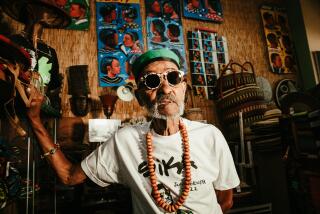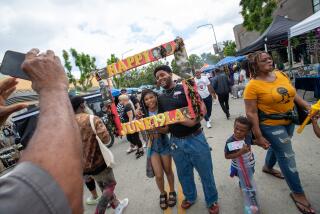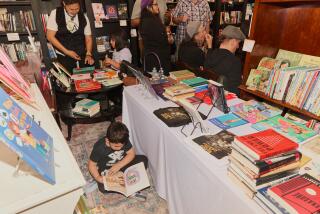Leimert Park Village Book Fair draws crowds to cultural heart of black L.A.
- Share via
Strolling down an aisle with hands clasped behind his back at the fourth annual Leimert Park Village Book Fair, Otis Wright noticed significant changes in the event as it unfolded Saturday in a neighborhood known as the cultural heartbeat of black Los Angeles.
Like similar literary festivals across the nation, the fair featured fiction, nonfiction, poetry and children’s literature by 150 African American writers, as well as readings, panel discussions and performances by singers, including a Lena Horne impersonator. The thousands of visitors who turned out had plenty of opportunities to meet authors and celebrities such as Oscar winner Lou Gossett Jr.
But Wright, 72, a real estate broker and minister who has lived in the Leimert Park Village area for 55 years, was particularly pleased by what he described as “progress: more people, a younger crowd this year, and lots more children. I like that.”
Nearby, 9-year-year-old Jada Salazar was exploring rows of long tables where dozens of independent authors were showing off their self-published efforts.
“It’s so inspiring that as soon as I get home I am going to write something about it,” said Salazar, vice president of the student body at Saturn Street Elementary School in the Mid-City area of Los Angeles. “I’m going to write about all the authors selling books and the people singing on stage.”
The festival was founded in 2007 by Cynthia E. Exum and Associates in partnership with Los Angeles Councilman Bernard C. Parks, whose district includes the southwest Los Angeles neighborhood rich with Art Deco apartments and office buildings, Afrocentric boutiques and shops such as Eso Won Books.
In a kickoff activity Saturday, Parks presided over the unveiling of a 44-cent U.S. postage stamp honoring Oscar Micheaux, the son of former slaves who went on to write, produce and direct 44 feature-length films between 1919 and 1948.
“This festival can be appreciated on many levels,” Parks said. “It is a celebration of the written word and presents role models from famous actors to little-known artists just starting to make their mark. It is also an economic stimulus because the crowds of book-lovers spill over into local shops and restaurants — and it’s getting bigger.”
Invited authors included Scot Brown, author of “Fighting for US: Maulana Karenga, the US Organization, and Black Cultural Nationalism”; Douglas A. Blackmon, author of “Slavery by Another Name”; and fashion consultant Daisy Lewellyn, author of “In Style With the Queen of Effortless Chic.”
On a panel about a collection of scholarly essays titled “Black Los Angeles: American Dreams and Racial Realities,” Paul Robinson, director of the Medical Geographic Information Systems Laboratory at Charles R. Drew University of Medicine and Science, presented a history of Los Angeles from its founding in 1781 by Spaniards of mostly African descent to the first decade of the 2000s, a time when the cultural fabric of American-born blacks is being challenged by new immigrants from the Caribbean and Africa.
These new immigrants share the same living spaces, he said, but have different cultural backgrounds and social identities.
Leimert Park is a microcosm of those changes. Developed in the late 1920s, the neighborhood was restricted to whites and known for its golf courses and several airstrips. Howard Hughes learned to fly there. The area began attracting African American musicians and artists after the 1965 Watts riots.
The Leimert Park Village shopping district features Jamaican shops and restaurants and Southern-style eateries offering live jazz. The bustling neighborhood surrounding the intersection of West 43rd Place and Degnan Boulevard celebrates Kwanzaa and Christmas and is the last stop on the annual parade honoring Martin Luther King Jr.
Noted philanthropists Bernard and Shirley Kinsey, whose extensive collection of art, books and manuscripts chronicle the African American experience from 1632 to the present, know the area well.
They are coauthors of “The Kinsey Collection,” a 155-page coffee-table edition that Bernard Kinsey said “is more about the African American experience in terms of ‘How we overcame’ than ‘Isn’t it awful?’ ”
Surveying the passersby, many of them with children in tow, Kinsey smiled and said: “I love what I see here today. This is the soul of the African American experience in Los Angeles. We are privileged to be a part of it.”
More to Read
Sign up for our Book Club newsletter
Get the latest news, events and more from the Los Angeles Times Book Club, and help us get L.A. reading and talking.
You may occasionally receive promotional content from the Los Angeles Times.








